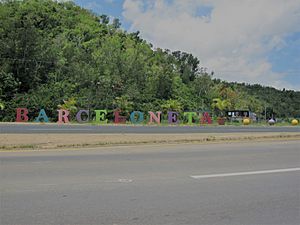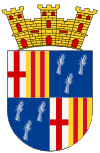Barceloneta, Puerto Rico facts for kids
Quick facts for kids
Barceloneta
Municipio Autónomo de Barceloneta
|
|||
|---|---|---|---|
|
Town and Municipality
|
|||

Barceloneta in letters sculpture
|
|||
|
|||
| Nicknames:
"La Ciudad de las Piñas", "La Ciudad Industrial," "El Pueblo de los Indios", "El Pueblo de Sixto Escobar"
|
|||
| Anthem: "Querido Barceloneta" | |||

Map of Puerto Rico highlighting Barceloneta Municipality
|
|||
| Sovereign state | |||
| Commonwealth | |||
| Settled | early 19th century | ||
| Founded | July 1, 1881 | ||
| Founded by | Bonocio Llenza Feliú | ||
| Named for | Barcelona | ||
| Barrios | |||
| Area | |||
| • Total | 36.39 sq mi (94.24 km2) | ||
| • Land | 32 sq mi (82 km2) | ||
| • Water | 4.73 sq mi (12.24 km2) | ||
| Population
(2020)
|
|||
| • Total | 22,657 | ||
| • Rank | 56th in Puerto Rico | ||
| • Density | 622.68/sq mi (240.418/km2) | ||
| Demonym(s) | Barcelonetences | ||
| Time zone | UTC−4 (AST) | ||
| ZIP Code |
00617
|
||
| Area code(s) | 787/939 | ||
| Major routes | |||
Barceloneta is a town and municipality in Puerto Rico. It is located on the northern coast, right next to the Atlantic Ocean. To its east is Manatí, and to its west is Arecibo.
Barceloneta is made up of three main areas called barrios, plus the downtown area known as Barceloneta Pueblo. It is also part of the larger San Juan-Caguas-Guaynabo metropolitan area.
Contents
What Does Barceloneta Mean?
The name Barceloneta means "Little Barcelona". It comes from the city of Barcelona in Spain. The town's founder was from there. Interestingly, there's also a famous beach and neighborhood in Barcelona called Barceloneta.
A Look at Barceloneta's History
How Barceloneta Was Founded
Barceloneta was founded on July 1, 1881. A man named Don Bonocio Llenza Feliú, who came from Barcelona, Spain, started the town. It was one of the last towns created by the Spanish government in Puerto Rico.
Early Growth and Changes
About ten years after it was founded, Barceloneta grew a lot. Its economy was strong thanks to agriculture and industry. By 1894, the town had many sugarcane farms and mills. They also grew other fruits.
In 1899, Barceloneta briefly joined the nearby town of Manatí. This happened after a big hurricane, Hurricane San Ciriaco, stopped an election about the change. But this merger didn't last long. Eleven years later, Barceloneta became its own municipality again.
From Sugarcane to Pineapples and Medicine
For a long time, sugarcane was very important. But in 1963, the main sugarcane mill closed. Barceloneta then focused on growing pineapples and other fruits.
The town's economy really changed in the 1970s. Many companies that make medicines, called pharmaceutical industries, started to build factories there.
Barceloneta's Port History
Because it's located near the Río Grande de Manatí, Barceloneta was once a busy port. Ships would carry sugar and salt from here. People could also travel by ship to New York City and Barcelona. Don Bonocio's son even owned a sail ship that made these trips.
Exploring Barceloneta's Geography
Barceloneta is in the northern part of Puerto Rico, right on the Atlantic Ocean. It shares borders with Arecibo, Florida, and Manatí. The municipality is shaped like a rectangle on the island's northern coast. It covers about 36.4 square miles (94.24 km2).
Land and Water Features
Most of Barceloneta's land is flat. However, since it's in a karst region, you can also find hills, sinkholes (called ponors), and caves. Near the coast, there's a large swampy area called the Tiburones cienaga.
The Río Grande de Manatí river flows through Barceloneta and into the Atlantic Ocean. Barceloneta is also home to the Caño Tiburones, which is the biggest swamp on the island.
Fun Things to Do in Barceloneta
Barceloneta has six beaches, including a unique black sand beach called Machuca.
Popular Places to Visit
- Antiguo Muelle (the old seaport)
- Cambalache Forest Reserve
- Caño Tiburones marshland
- La Monserrate Refinery Ruins
- Las Criollas Beach
- Marqués de la Esperanza Hacienda Ruins
- Palmas Altas Beach
- Sixto Escobar Museum: This museum honors the famous Puerto Rican boxer.
- Centro Cultural de Barceloneta: Located in the town center, this museum shares Barceloneta's culture and history. It also has old artifacts, including pieces from the Taíno people.
In 2021, the Puerto Rico Tourism Company started a campaign called Voy Turistiendo (I'm Touring). It encouraged people to visit different towns. Barceloneta's page in the campaign's passport book listed places like Malecón de la Boca, Antiguo Hospital Bonocio Llenza Feliú, La Mirada del Taíno, Semilla (for farm tourism), and Playa Arena Negra (Black Sand Beach).
Barceloneta's Culture
Festivals and Celebrations
Barceloneta celebrates its patron saint festival, the Fiestas Patronales de la Virgen del Carmen, in mid-July. This religious and cultural event usually lasts from Wednesday to Sunday. It includes parades, games, local crafts, amusement rides, traditional food, and live music. Famous artists often perform at this festival.
Barceloneta's Economy
Barceloneta is home to the largest group of pharmaceutical companies in the world. There are 14 such industries here! These companies chose Barceloneta because of its underground water. The water needs very little treatment to be used in making medicines.
These companies create many jobs. This has helped Barceloneta grow beyond just a place to work. The Puerto Rico Premium Outlets, located near the main highway, have made the town a popular shopping spot. This has also led to more restaurants and entertainment options. More jobs and attractions have caused Barceloneta's population to grow.
Population of Barceloneta
| Historical population | |||
|---|---|---|---|
| Census | Pop. | %± | |
| 1900 | 9,357 | — | |
| 1910 | 11,644 | 24.4% | |
| 1920 | 13,442 | 15.4% | |
| 1930 | 15,751 | 17.2% | |
| 1940 | 18,545 | 17.7% | |
| 1950 | 19,897 | 7.3% | |
| 1960 | 19,334 | −2.8% | |
| 1970 | 20,792 | 7.5% | |
| 1980 | 18,942 | −8.9% | |
| 1990 | 20,947 | 10.6% | |
| 2000 | 22,322 | 6.6% | |
| 2010 | 24,816 | 11.2% | |
| 2020 | 22,657 | −8.7% | |
| U.S. Decennial Census 1899 (shown as 1900) 1910-1930 1930-1950 1960-2000 2010 2020 |
|||
Symbols and Nicknames
The municipality of Barceloneta has its own official flag and coat of arms.
The Barceloneta Flag
Barceloneta's flag looks a lot like the flag of Barcelona in Spain. This is because the town is named after Barcelona. It has four sections. Two sections show the cross of Saint George, and two have five red and yellow stripes. These are all symbols from Barcelona and the region of Catalonia in Spain. The town's founder was from Catalonia. The other two sections of the flag are blue. This blue color stands for the Atlantic Ocean to the north of Barceloneta.
The Barceloneta Coat of Arms
Barceloneta's coat of arms also uses the same symbols from Catalonia as the flag. But it also shows three sugarcane flowers, called "guajanas," on top of the blue sections. These flowers represent how important sugarcane farming was to Barceloneta's old agricultural economy. The blue color also symbolizes the beaches and ports that helped the town's trade and industry. Like many coats of arms, it has a crown with three towers on top.
Fun Nicknames for Barceloneta
Barceloneta has a few cool nicknames:
- "La Ciudad de las Piñas" (Pineapple City): This is because of the many pineapple farms in the area.
- "La Ciudad Industrial" (Industrial City): This name comes from its many industries, especially the medicine factories.
- "Ciudad de los Indios" (City of the Indians): This name honors the native people.
- "Pueblo de Sixto Escobar" (Town of Sixto Escobar): This nickname is because the famous Puerto Rican boxer, Sixto Escobar, was born here.
Getting Around Barceloneta
Barceloneta has recently added free trolley cars for getting around town. If you need to travel outside Barceloneta, you can use carros publicos. These are like shared taxis.
There are also 9 bridges in Barceloneta.
Images for kids
See also
 In Spanish: Barceloneta (Puerto Rico) para niños
In Spanish: Barceloneta (Puerto Rico) para niños










